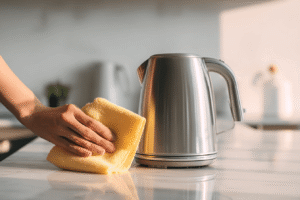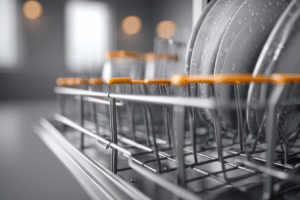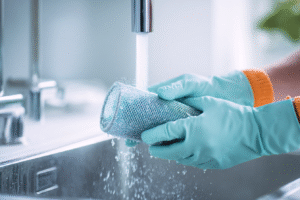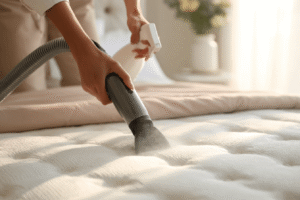Summarise this article with:
Your microwave works hard every day, heating everything from your morning porridge to last night’s leftovers. We know how quickly it can get messy with food splatters and stubborn stains. The good news? You don’t need harsh chemicals to get it sparkling clean again. We’ll show you how to tackle grease, grime and odours using simple natural ingredients you already have at home – lemon, white vinegar and baking soda. These gentle yet effective methods will have your microwave looking and smelling fresh in no time.
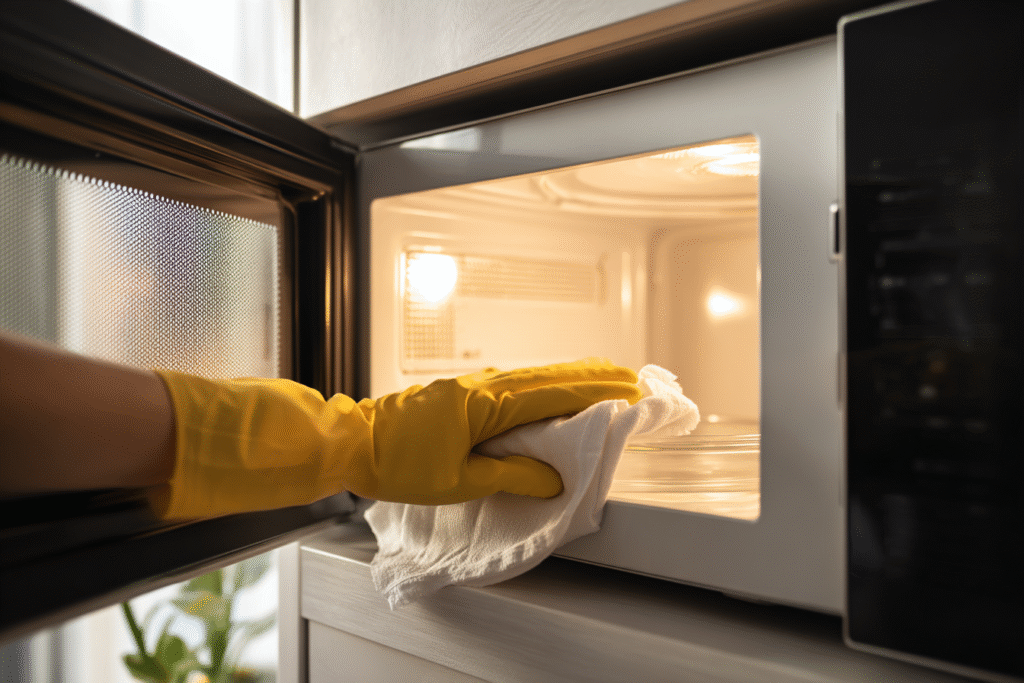
What You’ll Need for Natural Microwave Cleaning
Getting your microwave oven spotless requires just a few simple items from your kitchen cupboards. Here’s what to gather before you start:
Natural Cleaning Ingredients:
- White vinegar – acts as a natural deodoriser and cuts through grease
- Fresh lemons or lemon juice – citric acid breaks down stubborn stains
- Baking soda – perfect for tackling burnt-on food and odours
Essential Equipment:
- Microwave-safe bowl – for heating your cleaning solutions
- Cup of water – to create steam for easier cleaning
- Microfibre cloth or damp cloth – for wiping down surfaces
- Non-scratch scourer – for any persistent spots
You’ll find these effective ways to clean work brilliantly without harsh chemicals, and most items are already in your kitchen.
How to Clean a Microwave with Lemon
Benefits of Lemon Cleaning
Lemons are brilliant natural cleaners that offer several advantages over harsh chemicals. The citric acid works wonders at breaking down grease and grime, whilst the natural oils help eliminate stubborn food odours. You can also see our full guide on how to clean your microwave with lemon.
Why choose lemon for your microwave?
- Chemical-free cleaning – safe around food and family
- Natural deodoriser – leaves a fresh, citrus scent
- Gentle yet effective – won’t damage your microwave’s interior
- Cost-effective – uses ingredients you likely have at home
The steam created when heating lemon water inside of the microwave helps loosen dried-on splatters, making them easy to wipe away. Natural cleaning products like lemons also provide antibacterial properties, giving you peace of mind when cleaning an appliance used for food preparation.
Step-by-Step Lemon Method
Ready to get started? Here’s how to transform your grimy microwave oven using just lemon and water:
The Process:
- Prep your bowl: Fill a microwave-safe bowl halfway with water, then cut a fresh lemon in half and squeeze the juice in
- Add the lemon halves: Pop both squeezed lemon halves directly into the bowl – they’ll boost the cleaning power
- Heat it up: Place the bowl inside and run your microwave on full power for 3-5 minutes until the water boils vigorously
- Let the steam work: Keep the door closed for 5 minutes after heating – the lemony steam softens stubborn splatters
- Wipe clean: Remove the turntable first, then use a damp cloth to wipe down all surfaces, starting with the ceiling
For any persistent spots, dip your cloth in the leftover lemon water and give them a gentle scrub. Wash the turntable separately with warm water and dish soap.
Best Way to Clean with Vinegar
White vinegar stands out as the most powerful natural cleaner for your microwave. Mix equal parts water and distilled white vinegar in a microwave-safe container – this creates the perfect steam-cleaning solution.
Vinegar Cleaning Quick Reference:
| Vinegar Type | Water Ratio | Heating Time | Best For |
|---|---|---|---|
| White vinegar | 1:1 | 3–5 minutes | General cleaning & deodorising |
| Apple cider vinegar | 1:1 | 3–5 minutes | Stubborn grease |
The Method:
- Heat the mixture until it reaches a rolling boil and the window steams up
- Keep the door closed for 5 minutes after heating – let that vinegary steam do the hard work
- Remove the heated bowl carefully and wipe down all interior surfaces
The acetic acid cuts through grease effortlessly, whilst the steam loosens dried-on food. Your microwave will emerge fresh and sanitised without harsh chemicals.
Cleaning with Baking Soda for Stubborn Stains
When grease splatters and burnt-on food refuse to budge, baking soda becomes your secret weapon. This gentle abrasive tackles the toughest grime whilst absorbing lingering odours.
Quick Baking Soda Reference:
| Mix Ratio | Heating Time | Best For |
|---|---|---|
| 2 tbsp + 1 cup water | 3–5 minutes | General stubborn stains |
| 1/4 cup + water | 5 minutes | Heavy burnt-on food |
The Process:
- Dissolve baking soda completely in water using a microwave-safe bowl
- Heat until the mixture steams up the interior walls
- Keep the door open for a few minutes after heating to let excess steam escape safely
- Wipe down with a damp cloth – the loosened grime lifts away easily
For particularly stubborn spots, dip your cloth in the leftover baking soda solution for extra scrubbing power.
What Should You Not Clean a Microwave With?
Certain cleaning products can damage your microwave or create dangerous fumes when heated. Here’s what to steer clear of:
Never Use These Inside Your Microwave:
| Product Type | Why It’s Dangerous | Safe Alternative |
|---|---|---|
| Bleach-based cleaners | Creates toxic fumes when heated | White vinegar solution |
| Steel wool | Scratches interior surfaces | Soft microfiber cloth |
| Abrasive sponges | Damages protective coating | Non-scratch sponge |
| Oven cleaner | Too harsh for microwave materials | Baking soda paste |
Avoid These Materials:
- Clorox wipes inside the microwave (exterior only)
- Harsh chemicals with ammonia
- Multi-purpose sprays containing bleach
- Rough scrubbing pads or brushes
Stick to gentle, food-safe options that won’t leave harmful residues or damage your appliance’s interior.
How to Remove Smells and Deodorize
Natural Odour Removal Techniques
Lingering food smells can make your microwave less than pleasant to use. Fortunately, several natural ingredients excel at neutralising odours without masking them with artificial fragrances.
Coffee grounds work wonders for absorbing persistent smells. Place half a cup of used grounds in a bowl and leave overnight inside your microwave – they’ll soak up odours whilst leaving a subtle, pleasant aroma.
Vanilla extract offers another sweet-smelling solution. Mix four teaspoons with two cups of water, heat until boiling, then let it sit for 30 minutes with the door closed.
For overnight treatment, try these natural absorbers:
- Open box of baking soda left inside for 8-12 hours
- Bowl of activated charcoal (available from pet shops)
- Fresh citrus peels scattered on a plate
Each method tackles different types of odours, so rotate between them for the freshest results.
Preventing Future Smells
Smart habits keep your microwave fresh without constant deep cleaning. Cover your food with microwave-safe lids or plates – this simple step prevents 90% of splatter issues.
Daily Prevention Tips:
- Wipe spills immediately whilst they’re still warm
- Leave the door open for 2-3 minutes after heating smelly foods
- Use microwave-safe covers for saucy or greasy dishes
- Clean the turntable weekly with warm, soapy water
Weekly Maintenance Schedule:
| Day | Quick Action | Time Needed |
|---|---|---|
| Monday | Wipe interior walls | 30 seconds |
| Friday | Steam clean with water | 3 minutes |
Pop a small bowl of baking soda inside overnight once monthly to absorb any lingering odours. These simple routines mean you’ll rarely need those intensive cleaning sessions again. You can read our complete guide on cleaning your microwave with baking soda, white vinegar, and lemon. Follow these expert cleaners’ tips and your microwave will be spotless in minutes.
💡 Want to dive deeper?




